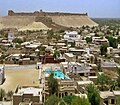 | The Harappan language is the unknown language or languages of the Bronze Age (c. 2nd millennium BC) Harappan civilization (Indus Valley civilization, or... 10 KB (959 words) - 22:56, 25 April 2024 |
 | Indus Valley Civilisation (redirect from Harappan Civilisation) World Heritage Site in 2021 as "Dholavira: A Harappan City"), and Rakhigarhi in Haryana. The Harappan language is not directly attested, and its affiliations... 187 KB (21,219 words) - 06:09, 26 April 2024 |
 | Indus script (redirect from Harappan script) whether or not they constituted a writing system used to record a Harappan language, any of which are yet to be identified. Despite many attempts, the... 61 KB (6,126 words) - 00:50, 17 April 2024 |
 | assumption. Linguist Asko Parpola writes that the Indus script and Harappan language are "most likely to have belonged to the Dravidian family". Parpola... 106 KB (9,580 words) - 08:31, 14 April 2024 |
Periodisation of the Indus Valley Civilisation (redirect from Pre-Harappan) the Indus Valley Civilisation was divided into Early, Mature, and Late Harappan by archaeologists like Mortimer Wheeler, newer periodisations include the... 27 KB (2,793 words) - 00:59, 21 October 2023 |
 | Bhirrana (section Period IB: Early Harappan Culture) alluvial sottar plain. Rao, who excavated Bhirrana, claims to have found pre-Harappan Hakra Ware in its oldest layers, dated at the 8th–7th millennium BCE. He... 21 KB (2,065 words) - 12:12, 23 April 2024 |
 | evidence supporting the theory. He also speculated that the Harappan language (the language of the Indus Valley civilization) might also have been part... 19 KB (2,067 words) - 19:49, 25 April 2024 |
 | Kalibangan (section Early Harappan Phase) called "Early Harappan or antecedent Harappan". Other nearby sites belonging to IVC include Balu, Kunal, Banawali etc. This Early Harappan phase (also called... 34 KB (4,552 words) - 18:12, 13 April 2024 |
script (speculated to record a "Harappan language") Cretan hieroglyphs and Linear A (encoding a possible "Minoan language") the Cypro-Minoan syllabary Earlier... 104 KB (6,111 words) - 07:10, 22 April 2024 |
 | Dravidian peoples (category Articles containing Sanskrit-language text) assumption. Linguist Asko Parpola writes that the Indus script and Harappan language are "most likely to have belonged to the Dravidian family". Parpola... 84 KB (7,575 words) - 16:58, 5 April 2024 |
 | Dholavira (category Articles containing Gujarati-language text) Dholavira's location is on the Tropic of Cancer. It is one of the five largest Harappan sites and the most prominent of archaeological sites in India belonging... 27 KB (2,696 words) - 18:42, 21 April 2024 |
inscription might provide some insights into the relationship between the Harappans and the Mesopotamians. Meluhha Sargon of Akkad Naram-Sin of Akkad "MS... 1 KB (109 words) - 20:34, 3 March 2024 |
 | Pearson Education. pp. 151–155. ISBN 978-81-317-1120-0. "Dholavira: a Harappan City". UNESCO World Heritage Centre. Retrieved 2022-01-14. Singh, Upinder... 8 KB (898 words) - 00:37, 26 January 2024 |
I: Pre-Harappan (Kalibangan)(c.2500-2300 BCE) Period IA: Pre-defence Phase Period IB: Defence Phase Period IC: Transitional Phase (Proto-Harappan) Period... 11 KB (1,224 words) - 15:02, 3 April 2024 |
 | Lothal (section Later Harappan culture) Sabarmati river on the trade route. This trade route stretched between Harappan cities in Sindh (Pakistan) and the peninsula of Saurashtra where the surrounding... 52 KB (6,226 words) - 08:24, 11 April 2024 |
 | engraving on a piece of red potsherd, discovered at Bhirrana, India, a Harappan site in Fatehabad district in Haryana, shows an image that is evocative... 13 KB (1,452 words) - 15:37, 26 April 2024 |
 | Amri, Sindh (section Pre-Harappan stage) common elements, later they came in contact with Harappan culture and fully developed into Harappan culture. Earliest examples of artifacts belonging... 11 KB (1,155 words) - 11:47, 27 December 2023 |
 | Afghanistan, was a trading colony of the Indus Valley civilization (or Harappan Civilization) established around 2000 BC on the Oxus river (Amu Darya)... 6 KB (667 words) - 13:37, 4 October 2022 |
 | to the Indus Valley civilisation, being part of the pre-Harappan (7000-3300 BCE), early Harappan (3300-2600 BCE), and the mature phase (2600-1900 BCE) of... 48 KB (4,595 words) - 07:38, 25 April 2024 |
 | the process. The new Pakistani authorities requested the return of the Harappan pieces excavated on their territory, but the Indian authorities refused... 25 KB (3,176 words) - 05:14, 29 March 2024 |
 | Kot Diji (category Articles containing Sindhi-language text) common elements, later they came in contact with Harappan culture and fully developed into Harappan culture. Earliest examples of artifacts belonging... 14 KB (1,665 words) - 03:21, 4 April 2024 |
 | Mohenjo-daro (category Articles containing Sindhi-language text) largest cities of the ancient Indus Valley Civilisation, also known as the Harappan Civilization, which developed c. 3000 BCE from the prehistoric Indus culture... 41 KB (4,617 words) - 03:20, 22 April 2024 |
 | the trend for Hindu interpretations of archaeological evidence from the Harappan sites was that of John Marshall, who in 1931 identified the following as... 55 KB (5,920 words) - 21:37, 7 March 2024 |
Substratum in Vedic Sanskrit (redirect from Substratum in the Vedic language) cities, befitting a post-Harappan time frame. In particular, Indo-Aryan words for plants stem in large part from other language families, especially from... 29 KB (3,449 words) - 06:35, 10 April 2024 |
Bargaon (archaeological site) (section Late Harappan) in Saharanpur District, Uttar Pradesh, India. This site belongs to late Harappan period, with a mixture of Ochre Coloured Pottery. Indus Valley civilization... 1 KB (81 words) - 20:00, 16 March 2023 |
 | List of inventions and discoveries of the Indus Valley Civilisation (category CS1 French-language sources (fr)) gateway of the city, and is generally known as the Dholavira Signboard. The Harappans had arranged and set pieces of the mineral gypsum to form ten large symbols... 26 KB (2,880 words) - 10:10, 14 February 2024 |




